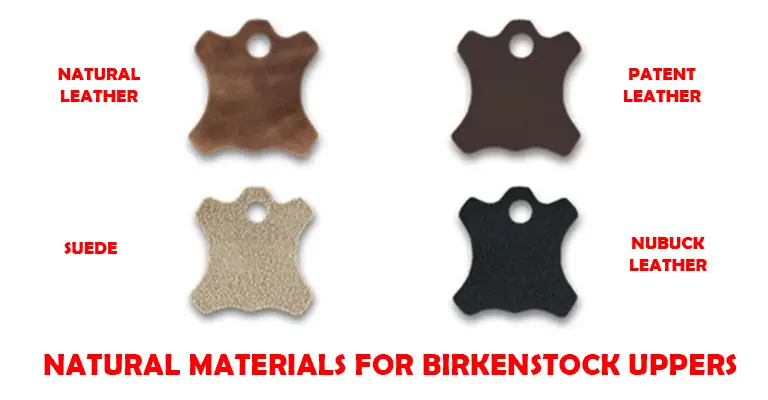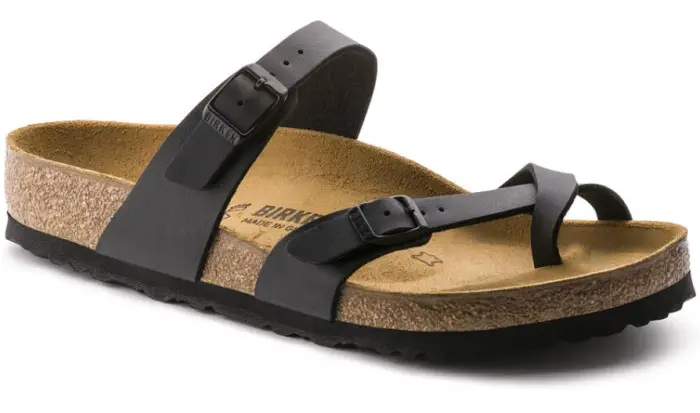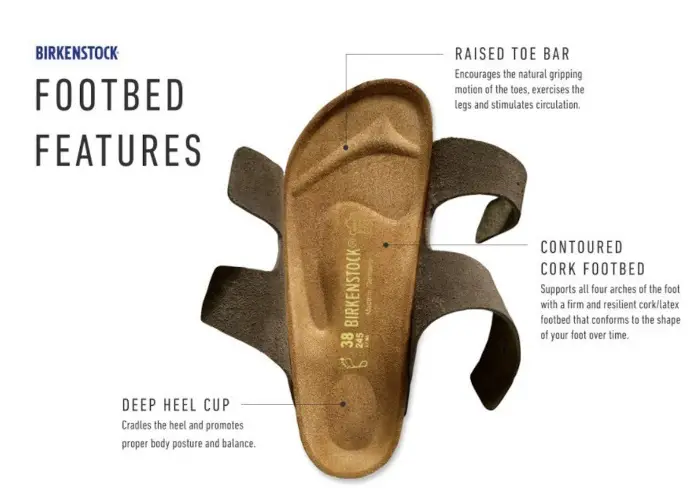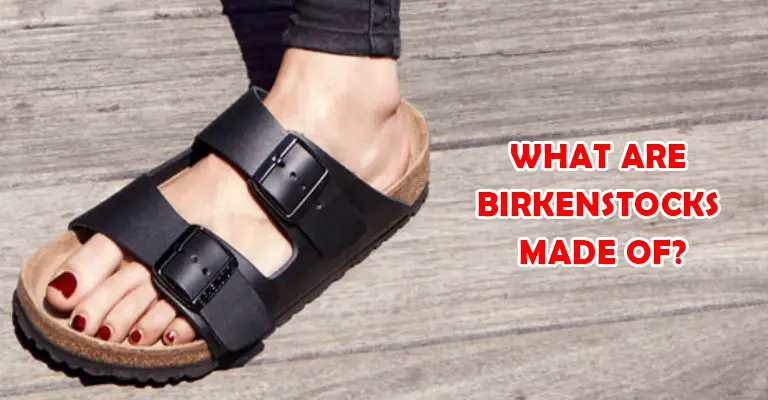Blog
What Are Birkenstocks Made Of?
As one of the most renowned footwear brands for comfort, Birkenstocks certainly incorporates nothing less than the best into their shoes.
But what are Birkenstocks made of? What kind of high-quality materials go into the production of such superior products?
There is no better way to find out than by breaking down every layer of Birkenstocks. That’s what Chooze Shoe does in today’s article.
Contents
What Are Birkenstocks Made Of?
All materials going into the production of Birkenstock shoes, clogs, and sandals are top-quality, whether they come from nature or a synthesis factory.
Birks also prioritizes the sustainability of what they use, which earns them more points from environmental lovers.
A good amount of leather is involved in the manufacture of Birkenstocks, mostly pig or cow skin. However, Birkenstocks often use pig skin for the lining.
On the other hand, vegan Birkenstocks use artificial materials instead of leather, such as wool felt or synthetic fibers.
Both of them feature the iconic Birkenstock footbed as well as accessories with the brand logo or name. And we are going to peel each layer of them off and see what they have got.
Materials For Birkenstock Uppers
“Quality you can feel. High-quality materials for an unforgettable comfort.”
Believing the upper of a shoe is the beginning of all virtues coming along, Birkenstocks use only the best materials that have passed their quality tests, such as unsplit leather, fine-textile fabrics, and premium synthetic fibers.

Natural Materials
Only the thickest and finest cuts of leather go for Birkenstocks. Dyed thoroughly and processed gently, they are ready for use without losing their precious natural properties: soft, breathable, and absorbent while still being extremely robust.
Natural Leather
You can recognize natural leather in Birkenstocks because they leave the surface untreated on purpose, so all original characteristics remain and thus maintain a distinctive appearance.
Every chosen cut of leather from Birks is a creation in itself. The standard thickness of the upper pieces is 2.8 – 3.2 millimeters.
Nubuck Leather
Nubuck has gone through subtle treatments to get the surface buffed and free from grains, hence it is extremely soft to the touch.
If you brush your finger over it, you will leave a visible mark because the fibers are easily displaced.
Nubuck needs to be waterproofed to stay healthy for a long time, because they are very sensitive and vulnerable to colors and moisture.
Patent Leather
It is a little different from other leather used in Birkenstock shoes, for it is a combination of different leather types: oiled leather, paint-coated leather, and plastic-coated leather.
The surface of patent leather is uniform with an extremely fine grain. The comprised leather types allow it to deal with external factors quite well, hence it is generally durable.
If you take care of your patent leather properly, it can stay with you for a very long time.
Suede
In contrast to nubuck, suede is leather buffed on the inside, so it becomes soft and resilient. You will sometimes see it referred to as buckskin.
The surface of suede retains its natural properties: fibrous, rough, and flexible. The pores are also far from plugged up, hence the entire fabric is always breathable.
Check more: Are Birkenstocks Good For Flat Feet? How And Why?
Synthetic Materials
High-quality materials with fine textiles are a great alternative to leather. They look good with beneficial properties for durability such as heat and moisture resistance.
Birkenstock also doesn’t reject the idea of fully artificial materials because they respond to the needs for aesthetics and low maintenance so well.
Felt
Made from synthesized fibers, the felt is thick and comfortable enough to keep your feet comfy without sacrificing the softness or the breathability.
Regardless of the design, the felt will always feel robust and durable so that you can rest assured your feet are always safe from any negative impact.
Wool Felt
Felt with a wool base is one of the finest natural fibers, and thus it has survived the test of time to remain relevant in the footwear industry. You will hardly find any textiles with an older origin.
You will certainly feel like you are stepping on clouds with how soft they are on your feet. Elasticity and temperature regulation only makes the experience even better.
Birko-Flor
Birko-Flor is a high-quality creation from Birkenstocks. This synthetic material has a PVC upper that is super easy and simple to care for. The inside is lined with soft fleece, hence it is gentle on the skin.
Durable enough to be dyed in a wide range of colors, it’s no wonder Birko-Flor has become a key material in Birkenstock production.

Birko Felt
Combine synthesized fibers with rayon, and you have Birko felt. It is a favorite for many people because of its softness and breathability for the skin while still maintaining a durable structure.
Birko Felt Nubuck
It looks terrifyingly like nubuck leather, yet it is a synthetic material that has been processed with special techniques. Even the sensation it gives you will remind you of the fine nubuck.
Materials for Birkenstock Footbed
Birkenstock refers to their well-known multi-layered footbed as “the heart of all our models”. And it’s true.
With the insoles made to anatomically mold to your feet and generously provide support, Birks divide the footbed they produce into two main categories.
- Classic
Standard toe bar with a slight raise and plenty of room, a longitudinal arch for proper gait, and a deep heel cup for natural cushioning – the Classic footbed from Birkenstocks is the more anatomically correct.
However, it requires some break-in time to reach its full potential.
- Soft
It takes away a bit of arch support, toe firmness, and depth in exchange for immediate comfort and more softness. Its performance won’t be enhanced with time, like the Classic footbed.
The footbed is where Birkenstocks show their intention for sustainability, with all materials having a natural origin.

Cork
Every Birkenstock has a cork layer as the core of its footbed. This material comes from the bark of cork oak trees, and they only harvest five centimeters of it every season. Hence, the trees can recover and reproduce themselves.
After harvesting, the cork will be cooked to ensure cleanness and hygiene.
Without any severe chemical process to endure, this material retains its unmatched and innate benefits like heat insulation, shock absorption, and elasticity.
Latex
Alongside the cork, latex makes up an important part of Birkenstock’s footbed. It is extracted from matured rubber trees (at least six years old), hence the source is absolutely renewable.
It serves as the binding agent for the layers of the footbed and helps the manufacturer avoid resorting to synthetic, oil-based latex.
The production of synthetic latex involves pollutants, and the final product is far from as good as what natural latex can provide.
Jute
Before the suede lining comes into contact with our feet, we have two jute layers wrapping around the cork and latex.
They reinforce the footbed for durability and stability as well as protect the more sensitive materials from environmental factors.
Materials for Birkenstock Buckles & Soles
While the legendary footbed is not visible at first sight, the buckles and the soles on Birkenstocks are something you will recognize anywhere.
Buckles
The straps on Birkenstock footwear are held by buckles and made adjustable so the fit can be customized for each individual.
These buckles are metal with removed nickel, coated with enamel for corrosion resistance, and engraved with the logo of the brand.
For better binding and fastening, Birkenstock also includes an array of rivets. With the logo embossed on the metallic surface, these rivets are also extremely eye-catching.
Soles
If a shoe is a construction, the sole is its foundation. Since it is always in contact with the terrain, scuff and slip resistance is mandatory.
Your purpose determines the type of soles you need, and the quality of the soles is determined by the materials used.
The soles of Birkenstocks are made of EVA and/or rubber with specific patterns for treading. They are classified into several types.
- EVA sandal sole is the classic with bone pattern for treading. The manufacturer punches EVA plates and creates these soles before adhering them to the footbed with heat-sensitive adhesive.
- EVA molded sole is also EVA but light and soft enough for flexibility and an understated appearance while not sacrificing the firm grip.
- EVA lightweight sole is incredibly enhanced in terms of lightness. You can find the signature tread pattern at the edge of the heel, along with blue rubber with a logo inlay.
- The Retro Sneaker sole is real rubber with scuff resistance and flexibility. Aside from the bone pattern, it features a seam to sew the sole to the upper.
- The sawtooth sole is high-quality real rubber with asymmetrical tread patterns for both fashion and flexibility.
- Romantic Dressy sole is an elegant creation of real rubber with bone patterns on the forefoot while the heel remains smooth with a logo inlay.
- The Work Boot sole is the sturdiest among all Birkenstock soles, made of thermoplastic rubber with similar properties to natural rubber but much lighter.
Closing Words
Once we break down what materials Birkenstocks are made of, the high-quality performance they offer suddenly feels more realistic and less than a myth.
Are you in love with the leather products they offer, or is sustainability more important to you than anything else?
No matter what you choose, Birkenstock will stay true to its ethics and provide some of the most intricate models of comfort footwear that you can find on the market.

